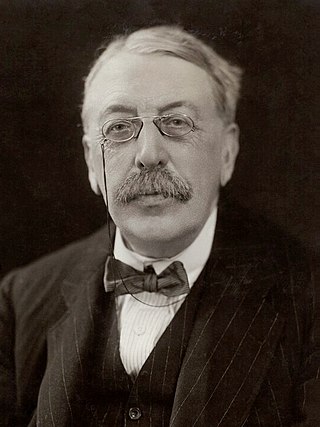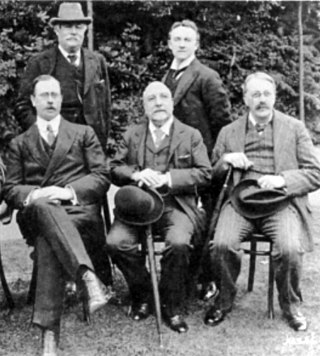
Gustav Theodore Holst was an English composer, arranger and teacher. Best known for his orchestral suite The Planets, he composed many other works across a range of genres, although none achieved comparable success. His distinctive compositional style was the product of many influences, Richard Wagner and Richard Strauss being most crucial early in his development. The subsequent inspiration of the English folksong revival of the early 20th century, and the example of such rising modern composers as Maurice Ravel, led Holst to develop and refine an individual style.

Ralph Vaughan Williams was an English composer. His works include operas, ballets, chamber music, secular and religious vocal pieces and orchestral compositions including nine symphonies, written over sixty years. Strongly influenced by Tudor music and English folk-song, his output marked a decisive break in British music from its German-dominated style of the 19th century.

Sir Charles Hubert Hastings Parry, 1st Baronet, was an English composer, teacher and historian of music. Born in Richmond Hill in Bournemouth, Parry's first major works appeared in 1880. As a composer he is best known for the choral song "Jerusalem", his 1902 setting for the coronation anthem "I was glad", the choral and orchestral ode Blest Pair of Sirens, and the hymn tune "Repton", which sets the words "Dear Lord and Father of Mankind". His orchestral works include five symphonies and a set of Symphonic Variations. He also composed the music for Ode to Newfoundland, the Newfoundland and Labrador provincial anthem.

Sir Charles Villiers Stanford was an Anglo-Irish composer, music teacher, and conductor of the late Romantic era. Born to a well-off and highly musical family in Dublin, Stanford was educated at the University of Cambridge before studying music in Leipzig and Berlin. He was instrumental in raising the status of the Cambridge University Musical Society, attracting international stars to perform with it.

Herbert Norman Howells was an English composer, organist, and teacher, most famous for his large output of Anglican church music.

Ernest John Smeed Moeran was an English composer whose work was strongly influenced by English and Irish folk music of which he was an assiduous collector. His output includes orchestral pieces, concertos, chamber and keyboard works, and a number of choral and song cycles as well as individual songs.

Philip Arnold Heseltine, known by the pseudonym Peter Warlock, was a British composer and music critic. The Warlock name, which reflects Heseltine's interest in occult practices, was used for all his published musical works. He is best known as a composer of songs and other vocal music; he also achieved notoriety in his lifetime through his unconventional and often scandalous lifestyle.

Edmund Rubbra was a British composer. He composed both instrumental and vocal works for soloists, chamber groups and full choruses and orchestras. He was greatly esteemed by fellow musicians and was at the peak of his fame in the mid-20th century. The best known of his pieces are his eleven symphonies. Although he was active at a time when many people wrote twelve-tone music, he decided not to write in this idiom; instead, he devised his own distinctive style. His later works were not as popular with the concert-going public as his previous ones had been, although he never lost the respect of his colleagues. Therefore, his output as a whole is less celebrated today than would have been expected from its early popularity. He was the brother of the engineer Arthur Rubbra.

Imogen Clare Holst was a British composer, arranger, conductor, teacher, musicologist, and festival administrator. The only child of the composer Gustav Holst, she is particularly known for her educational work at Dartington Hall in the 1940s, and for her 20 years as joint artistic director of the Aldeburgh Festival. In addition to composing music, she wrote composer biographies, much educational material, and several books on the life and works of her father.
Herbert Whitton Sumsion was an English musician who was organist of Gloucester Cathedral from 1928 to 1967. Through his leadership role with the Three Choirs Festival, Sumsion maintained close associations with major figures in England's 20th-century musical renaissance, including Edward Elgar, Herbert Howells, Gerald Finzi, and Ralph Vaughan Williams. Although Sumsion is known primarily as a cathedral musician, his professional career spanned more than 60 years and encompassed composing, conducting, performing, accompanying, and teaching. His compositions include works for choir and organ, as well as lesser-known chamber and orchestral works.

Classical music of the United Kingdom is taken in this article to mean classical music in the sense elsewhere defined, of formally composed and written music of chamber, concert and church type as distinct from popular, traditional, or folk music. The term in this sense emerged in the early 19th century, not long after the United Kingdom of Great Britain and Ireland came into existence in 1801. Composed music in these islands can be traced in musical notation back to the 13th century, with earlier origins. It has never existed in isolation from European music, but has often developed in distinctively insular ways within an international framework. Inheriting the European classical forms of the 18th century, patronage and the academy and university establishment of musical performance and training in the United Kingdom during the 19th century saw a great expansion. Similar developments occurred in the other expanding states of Europe and their empires. Within this international growth the traditions of composition and performance centred in the United Kingdom, including the various cultural strands drawn from its different provinces, have continued to evolve in distinctive ways through the work of many famous composers.
Patrick Arthur Sheldon Hadley was a British composer.
The Frankfurt Group, also called the Frankfurt Gang or the Frankfurt Five, was a group of English-speaking composers and friends who studied composition under Iwan Knorr at the Hoch Conservatory in Frankfurt am Main in the late 1890s. The group included H. Balfour Gardiner, Norman O'Neill, Cyril Scott and Roger Quilter, who were all English, and Percy Grainger and Frederick Septimus Kelly, who were born in Australia but established themselves as composers in England. Although they did not study in Frankfurt all at the same time they remained close friends from their student days onwards.
The Bach Choir is a large independent musical organisation founded in London, England in 1876 to give the first performance of J. S. Bach's Mass in B minor in Britain.

The English Musical Renaissance was a hypothetical development in the late 19th and early 20th century, when British composers, often those lecturing or trained at the Royal College of Music, were said to have freed themselves from foreign musical influences, to have begun writing in a distinctively national idiom, and to have equalled the achievement of composers in mainland Europe. The idea gained considerable currency at the time, with support from prominent music critics, but from the latter part of the 20th century has been less widely propounded.

Jane Marian Joseph was an English composer, arranger and music teacher. She was a pupil and later associate of the composer Gustav Holst, and was instrumental in the organisation and management of various of the music festivals which Holst sponsored. Many of her works were composed for performance at these festivals and similar occasions. Her early death at age 35, which prevented the full realisation of her talents, was considered by her contemporaries as a considerable loss to English music.
This is a summary of 1928 in music in the United Kingdom.
This is a summary of 1925 in music in the United Kingdom.

The Hymn of Jesus, H. 140, Op. 37, is a sacred work by Gustav Holst scored for two choruses, semi-chorus, and full orchestra. It was written in 1917–1919 and first performed in 1920. One of his most popular and highly acclaimed compositions, it is divided into two sections. The Prelude presents the plainsong Pange lingua and Vexilla regis first instrumentally and then chorally; the second section, the Hymn, is a setting of his own translation of the Hymn of Jesus from the Apocryphal Acts of St John.

"This Have I Done for My True Love", or "Tomorrow Shall Be My Dancing Day", Op. 34, no. 1 [H128], is a motet or part song composed in 1916 by Gustav Holst. The words are taken from an ancient carol, and the music is so strongly influenced by English folk music that it has sometimes been mistaken for a traditional folk song itself. It has often been described as a small masterpiece.













